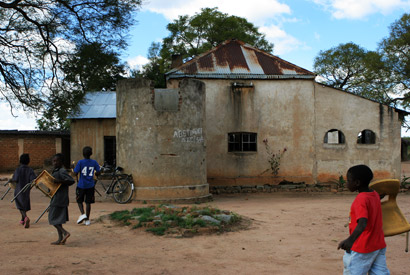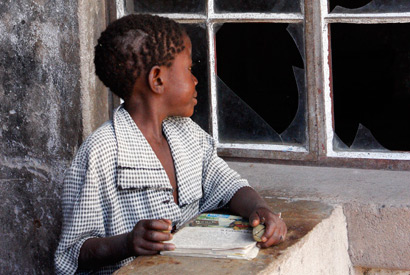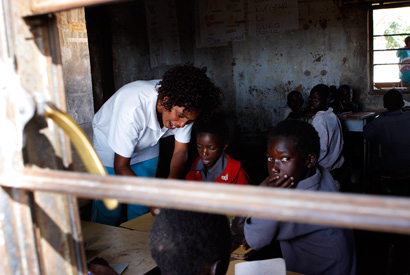
The school building at Simakakata. The borehole in front is dry.
Why does the community of Simakakata need a school?
The current school is in a near derelict farmhouse. Most of the windows are smashed and the panels of the corrugated iron roof are punched through with holes. In places the sheets simply don’t join, leaving gaps running half the length of a classroom.
The walls are cracked and crumbling, because they seep with water in the rain then dry quickly in the burning sun. Despite the fact they are so open to the elements, the school refuses to close during the five month rainy season in Zambia, when sporadic storms pour into classrooms and make teaching impossible.
The borehole in the compound ran dry months ago, leaving the school without water. There’s one dry latrine for the 119 boys and 111 girls who study here.
Don’t even own the school
To make matters worse, the community doesn’t even own the building. Even if the farmhouse and borehole could be renovated, its owned by another organisation and the school was supposed to move out in October.

Looking into the dark classroom
Many of the children leave home at five o’clock in the morning, and won’t be back for 11 hours. Some will do homework, most will help their families with chores or caring for livestock.
When they get here in the morning, the rooms are dark – they stay that way all day. There’s no power for electric lights, and reading is almost impossible. Children squeeze three or four around a desk made for one. Some stand for the whole lesson, others balance on metal framed chairs that are missing a leg.
Absenteeism here can be high, as students are often pulled out of school to work for their families, or are simply too weak from hunger to make the daily journey. The classes for grade one and grade two are often put together because there aren’t enough pupils to make a higher grade class possible.
With such basic facilities, it’s a wonder they both turning up at all.
But they do. And they love their lessons.

Sonia teaching the grade 1 & 2 pupils
Sonia Haloba Shanegubo teaches first and second grade students, and invites us to sit in on one of her classes. When she asks for a volunteer to come and count the number of apples she’s drawn on the blackboard, all 26 hands shoot into the air with a cry familiar to kids of every background.
“Teacher! Me!”
Sonia is proud of her proteges – especially the ones who’ve told her they want to be teachers when too when they grow up. She leads them in a special end of class song, Notuli Kumaanda, which the children dance to before leaving to play in the yard.
Sonia shows us their exercise books with pride, all have the right answers. She sighs as she picks one of them up.
“You see this one,” she says, “He writes his numbers on their sides still. This is because there were no trained teachers here until three years ago. The standards were very bad.”
A new, properly equipped classroom which Sonia’s class can make their permanent home will cost just £5,200 , a small part of the total for a new school. Please help.


